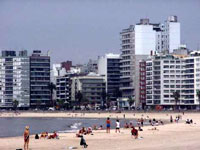 Montevideo OverviewFrom the air the city of Montevideo, capital of Uruguay, sprawls
as a grey morass across the wide Rio Plata estuary where two vast
rivers, the Parana and Uruguay, enter the Atlantic, often churning
the sea with a coffee-coloured silt. Water is the reason for Montevideo's existence, and the means of
its livelihood, with an extremely busy working harbour where cargo
ships constantly come and go and cranes reach into the sky. The site was originally a native Indian settlement 'discovered'
by a Portuguese explorer in 1516. A colony was not established
until about a century later, and was eventually taken over by the
Spanish who stormed the Portuguese fort in 1724. The Spanish
formally founded the city in 1726, and in 1828 Montevideo became
the capital of an independent Uruguay. The city's more recent
history has seen it besieged by Argentinean dictator Juan Manuel de
Rosas on two occasions, and endure the Battle of the River Plate
between German and British naval ships at the start of World War
II. Today Montevideo is one of Latin America's most vibrant cities,
popular with holidaymakers because of its miles of beaches and its
shabby sophistication. One traveller has aptly described the city
as feeling like 'Boston with a touch of Lisbon'. Visitors and locals can browse the enticing Mercado de los
Artesanos for leather goods, hand-knitted sweaters and other
tempting crafts; stroll the Rambla along the waterfront where there
are superb views and there is always a whole lot of activity; dine
on mouth-watering grilled steaks or perfect paella in the
restaurants of Mercado del Puerto; and end the day with a
tantalising tango at one of the numerous night-clubs. |